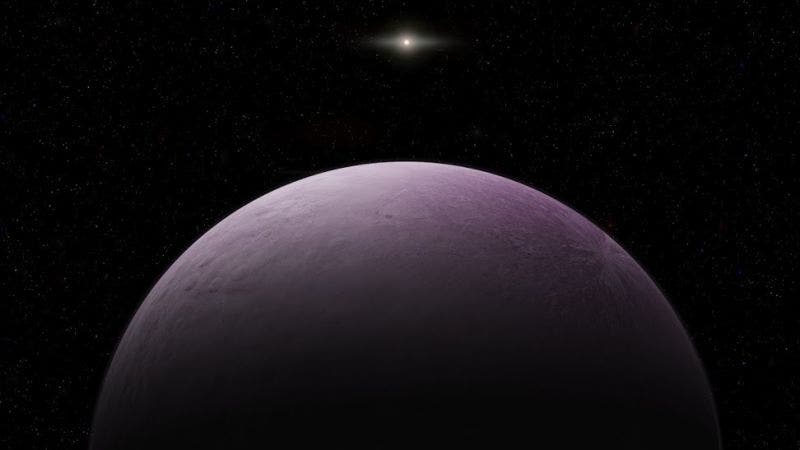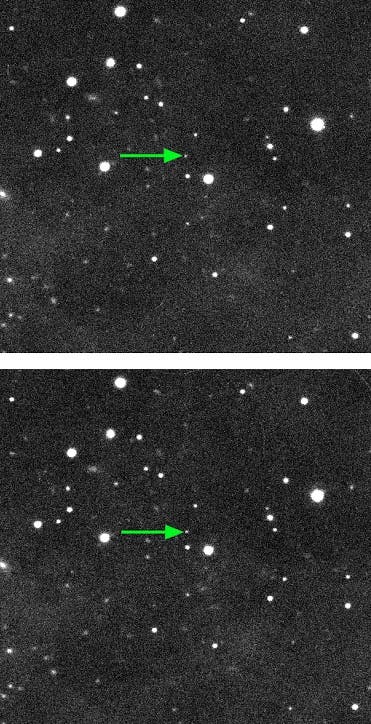
Artist impression of 2018 VG18, or “Farout.” Credit: Roberto Molar Candanosa/Carnegie Institution for Science.
Until not too long ago, Pluto’s orbit represented the known edge of our solar system. Then, new astronomical technology and improved observation methods revealed that our solar system is much more vast than initially thought. Astronomers have since discovered all sorts of icy objects beyond the Kuiper belt, the circumstellar disc that extends beyond the orbit of Neptune. To get an idea of our solar system’s expanse, imagine that recently researchers have found an object that orbits at more than 100 times the distance from Earth to the sun — it’s the farthest object we’ve encountered thus far.
Early last month, the Japanese Subaru 8-meter telescope at Mauna Kea, Hawaii, caught sight of a faint pink dot that was moving very slowly. Follow-up observations performed at the Las Campanas Observatory in Chile confirmed that the faint dot is actually a 300-mile-wide icy world. That would make it spherical and a dwarf planet.
This week, the International Astronomical Union’s Minor Planet Center announced the discovery and gave this object the designation 2018 VG18. However, it has a much more memorable (and fitting) nickname: ‘Farout’.

The distance of 2018 VG18 from the sun compared to other known Solar System objects. Credit: Roberto Molar Candanosa/Scott S. Sheppard/Carnegie Institution for Science.
Farout lies about 120 astronomical units (AU) from the sun — where one AU is the distance between Earth and the sun — which translates into about 93 million miles. That’s also about where the solar system starts to blend with interstellar space. Recently, NASA’s Voyager 2 spacecraft traveled more than 120 AUs, leaving the sun’s heliopause — the theoretical boundary where the Sun’s solar wind is stopped by the interstellar medium.
At such a great distance, the gravitational influence of the sun is less pronounced, so objects orbit at a much slower speed. For instance, Farout takes more than a 1,000 years to complete a full orbit around the sun.

Two photos of 2018 VG18 taken on November 10, 2018, one hour apart. The distant object is so far away from the sun that it takes more than 1,000 years to complete a full orbit. Image: Scott S. Sheppard/David Tholen.
But while Farout now holds the record for the most distant object ever observed in the solar system that doesn’t mean that there aren’t other things even farther away. As Space.com notes, “the dwarf planet Sedna gets more than 900 AU away on its highly elliptical orbit, for example, and there are probably trillions of comets in the Oort Cloud, which lies between about 5,000 AU and 100,000 AU from the sun.”
“2018 VG18 is much more distant and slower moving than any other observed solar system object, so it will take a few years to fully determine its orbit,” Scott Sheppard, a researcher at the Carnegie Institution for Science said in the statement. “But it was found in a similar location on the sky to the other known extreme solar system objects, suggesting it might have the same type of orbit that most of them do. The orbital similarities shown by many of the known small, distant solar system bodies was the catalyst for our original assertion that there is a distant, massive planet at several hundred AU shepherding these smaller objects.”
Astronomers were actually fixing their telescopes in search for a much more interesting prize — the elusive Planet Nine, which indirect evidence suggests it is pulling strings throughout the solar system by stretching the orbits of distant bodies and, perhaps, even tilting the plane of the entire solar system on one side. Astronomers think that Planet Nine can be found in an orbit that lies between hundreds of AUs and thousands of AUs.
“This would be a real ninth planet,” said Mike Brown, a planetary astrophysicist at the California Institute of Technology (Caltech) and one of the people responsible for de-classifying Pluto as a planet. “There have only been two true planets discovered since ancient times, and this would be a third. It’s a pretty substantial chunk of our solar system that’s still out there to be found, which is pretty exciting.”









